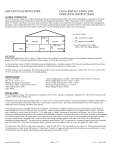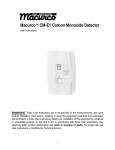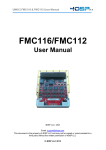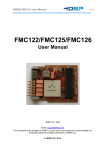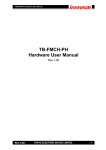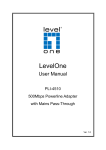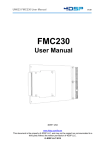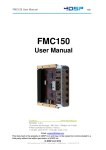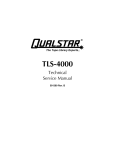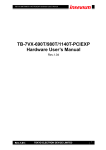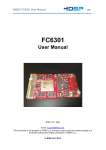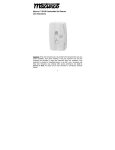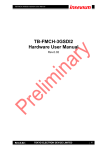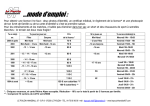Download FMC110 User Manual
Transcript
FMC110 User Manual r1.6 FMC110 User Manual 4DSP LLC 10713 Ranch Road 620 N, Suite 522, Austin, TX 78726, USA Email: [email protected] This document is the property of 4DSP LLC and may not be copied nor communicated to a third party without the written permission of 4DSP LLC. © 4DSP LLC. 2010 FMC110 User Manual r1.6 Revision History Date Revision Revision 2010-06-01 Initial release 1.0 2010-07-01 Update in Temperature and voltage parameters table. 1.1 2010-09-01 Added details about programming the FMC110, including SPI timing waveforms. Added FMC signal description in the Appendix. Added CPLD register definition in the Appendix. 1.2 2010-09-20 Updated photo. Modified block diagram. 1.3 2010-10-03 Text corrections in pin list. 1.4 2010-10-12 Update address. Update block diagram 1.5 2011-01-21 Correction in section 4.1.2. 1.6 4DSP est distribué par TECHWAY - www.techway.fr - [email protected] - +33 (0)1 64 53 37 90 FMC110 User Manual January 2011 www.4dsp.com -2- FMC110 User Manual r1.6 Table of Contents 1 2 3 4 5 6 7 8 Acronyms and related documents ............................................................................. 5 1.1 Acronyms ................................................................................................................ 5 1.2 Related Documents ................................................................................................. 5 General description ..................................................................................................... 6 Installation ................................................................................................................... 7 3.1 Requirements and handling instructions .................................................................. 7 3.2 LVDS requirements ................................................................................................. 7 Design .......................................................................................................................... 8 4.1 Phycisal specifications ............................................................................................ 8 4.1.1 Board Dimensions ............................................................................................ 8 4.1.2 Front panel coax inputs .................................................................................... 8 4.1.1 Front panel HDMI I/O ....................................................................................... 8 4.1.1 Front I/O (LVTTL/TTL)...................................................................................... 8 4.2 Electrical specifications ........................................................................................... 9 4.2.1 EEPROM ......................................................................................................... 9 4.2.1 JTAG................................................................................................................ 9 4.2.1 FMC HPC......................................................................................................... 9 4.3 Main characteristics................................................................................................11 4.4 Analog input channels ............................................................................................12 4.5 Analog output channels ..........................................................................................12 4.6 External clock input ................................................................................................12 4.7 External trigger/sync input ......................................................................................12 4.8 Clock Tree..............................................................................................................13 4.8.1 Control ............................................................................................................14 4.9 Multi-Gigabit Transceivers ......................................................................................14 4.10 Power supply ......................................................................................................16 4.11 Parallel A/D operation (Fs up to 2GHz) ...............................................................17 4.12 Synchronizing multiple cards ..............................................................................18 Controlling the FMC110..............................................................................................18 5.1 Architecture ............................................................................................................19 5.2 SPI Programming ...................................................................................................20 Environment................................................................................................................21 6.1 Temperature ..........................................................................................................21 6.2 Monitoring ..............................................................................................................21 6.3 Cooling ...................................................................................................................22 6.3.1 Convection cooling ..........................................................................................22 6.3.2 Conduction cooling ..........................................................................................22 Safety...........................................................................................................................22 EMC .............................................................................................................................23 4DSP est distribué par TECHWAY - www.techway.fr - [email protected] - +33 (0)1 64 53 37 90 FMC110 User Manual January 2011 www.4dsp.com -3- FMC110 User Manual r1.6 9 Warranty ......................................................................................................................23 Appendix A HPC pin-out FMC110 .................................................................................24 Appendix B CPLD Register map ...................................................................................28 4DSP est distribué par TECHWAY - www.techway.fr - [email protected] - +33 (0)1 64 53 37 90 FMC110 User Manual January 2011 www.4dsp.com -4- FMC110 User Manual r1.6 1 Acronyms and related documents 1.1 Acronyms ADC DDR EPROM FBGA FMC FPGA JTAG LED LVTTL LSB LVDS MGT MSB PCB PLL PSSR Analog to Digital Converter Double Data Rate Erasable Programmable Read-Only Memory Fineline Ball Grid Array FPGA Mezzanine Card Field Programmable Gate Array Join Test Action Group Light Emitting Diode Low Voltage Transistor Logic level Least Significant Bit(s) Low Voltage Differential Signaling Multi-Gigabit Transceiver Most Significant Bit(s) Printed Circuit Board Phase Locked Loop Power Supply Rejection Ratio Table 1: Glossary 1.2 Related Documents • • • • • FPGA Mezzanine Card (FMC) standard ANSI/VITA 57.1-2010 Datasheet ADS5400, TI Datasheet DAC5681Z, TI Datasheet AD9517, Analog Devices Datasheet ADT7411 Rev B, Analog Devices 4DSP est distribué par TECHWAY - www.techway.fr - [email protected] - +33 (0)1 64 53 37 90 FMC110 User Manual January 2011 www.4dsp.com -5- FMC110 User Manual r1.6 2 General description The FMC110 is a dual channel A/D and dual channel D/A FMC daughter card. The card provides two 12-bit A/D channels and two 16-bit D/A channels that enable simultaneous sampling at a maximum rate of 1 Gsps. The sample clock can be supplied externally through a coax connection or supplied by an internal clock source (optionally locked to an external reference). Additionally a trigger input for customized sampling control is available. The FMC110 daughter card is mechanically and electrically compliant to FMC standard (ANSI/VITA 57.1). The card has a high-pin count connector, front panel I/O, and can be used in a conduction cooled environment. The FMC110 allows flexible control on clock source, sampling frequency, and calibration through a SPI communication bus. Furthermore the card is equipped with power supply and temperature monitoring and offers several power-down modes to switch off unused functions. HDMI MICTOR 38-pins Multi Gigabit Transceiver (optional) MICTOR 38-pins Multi Gigabit Transceiver (optional) FMC High-pin Count 400-pins LVDS Figure 1: FMC110 block diagram 4DSP est distribué par TECHWAY - www.techway.fr - [email protected] - +33 (0)1 64 53 37 90 FMC110 User Manual January 2011 www.4dsp.com -6- FMC110 User Manual r1.6 3 Installation 3.1 Requirements and handling instructions • • • • 3.2 The FMC110 daughter card must be installed on a carrier card compliant to the FMC standard. The FMC carrier card must support the high-pin count connector (HPC 400-pins). The FMC carrier card must support VADJ/VIO_B voltage of +2.5V (LVDS support). Do not flex the card and prevent electrostatic discharges by observing ESD precautions when handling the card. LVDS requirements The A/D channels based on TI’s ADS5400 can operate in 1-bus or 2-bus mode. In 1-bus mode all data is transferred to output port A at a maximum rate of 1Gbps per DDR LVDS pair. In 2-bus more the data is de-multiplexed over output port A and B at a maximum rate of 500Mpbs per DDR LVDS pair. Output port B of one A/D channel is not available due to the limited amount of LVDS connections on the FMC connector. In 2-bus mode the sync feature can be used to re-align the data coming from the two separate paths on the carrier board. Each D/A channels have an independent DDR LVDS data bus. The full rate of 1Gsps is supported, but the digital transfer rate can be lowered by enabling the interpolation (x2 or x4) in the D/A devices. 4DSP est distribué par TECHWAY - www.techway.fr - [email protected] - +33 (0)1 64 53 37 90 FMC110 User Manual January 2011 www.4dsp.com -7- FMC110 User Manual r1.6 4 Design 4.1 Phycisal specifications 4.1.1 Board Dimensions The FMC110 card complies with the FMC standard known as ANSI/VITA 57.1. The card is a single width conduction cooled mezzanine module (with region 1 and front panel I/O). 4.1.2 Front panel coax inputs There are 6 coax connectors available from the front panel. From top to bottom; 1st analog input (A), 1st analog output (B), 2nd analog output (C), 2nd analog input (D), clock input (CL), trigger input (TR). Figure 2: Bezel drawing 4.1.1 Front panel HDMI I/O The 19-pins HDMI connector on the front panel (IO) holds 4 Multi gigabit transceivers (2 Tx pairs / 2 Rx pairs) and 4x LVTTL I/O (5V tolerant). Contact 4DSP for other configurations. Pin Number 1 2 3 4 5 6 7 8 9 10 Signal Name DP_M2C_P<0> Shield DP_M2C_N<0> DP_M2C_P<1> Shield DP_M2C_N<1> DP_C2M_P<2> Shield DP_C2M_N<2> DP_C2M_P<3> Pin Number 20 19 18 17 16 15 14 13 12 11 Signal Name GND N.C. N.C. N.C. FRONT_IO<1> FRONT_IO<0> FRONT_IO<3> FRONT_IO<2> DP_C2M_N<3> Shield Table 2. HDMI connector pin out 4.1.1 Front I/O (LVTTL/TTL) A voltage translator is used for the (LV)TTL signals available on the front panel. The FMC side is 2.5V. The front side is either 3.3V for LVTTL or 5.0V for TTL (build option). These inputs are 5V tolerant when powered with 3.3V. The direction is controlled by the CPLD. 4DSP est distribué par TECHWAY - www.techway.fr - [email protected] - +33 (0)1 64 53 37 90 FMC110 User Manual January 2011 www.4dsp.com -8- FMC110 User Manual 4.2 r1.6 Electrical specifications The FMC110 uses high speed LVDS outputs and require +2.5V on VADJ power supply (supplied by the carrier card). The voltage on VIO_B pins (supplied by the FMC) is also +2.5V. VIO_B is directly connected the VADJ on the FMC110. 4.2.1 EEPROM The FMC110 card carries a 2Kbit EEPROM (24LC02B) which is accessible from the carrier card through the I2C bus. The EEPROM is powered by 3P3VAUX. The standby current is only 0.01µA when SCL and SDA are kept at 3P3VAUX level. These signals may also be left floating since pull-up resistors are present on the card. 4.2.1 JTAG The CPLD device is included in the JTAG chain accessible from the FMC connection. The user should NOT reprogram or erase the CPLD. 4.2.1 FMC HPC The high-pin count connector has 4 dedicated LVDS clock pairs and can host up to 80 LVDS (data) pairs. Refer to appendix A for a detailed pin-out. 4DSP est distribué par TECHWAY - www.techway.fr - [email protected] - +33 (0)1 64 53 37 90 FMC110 User Manual January 2011 www.4dsp.com -9- FMC110 User Manual r1.6 # Pairs # Clock pairs LVDS Clock 1 1 LVDS Trigger 1 1 LVDS Sync 1 1 # Data pairs ADC #1 (port A) 14 LVDS Clock 1 LVDS Data 12 LVDS Ovr / LVDS Sync ADC #1 (port B) 1 13 LVDS Clock 0 LVDS Data 12 LVDS Ovr / LVDS Sync 1 ADC #2 (port A) 14 LVDS Clock 1 LVDS Data 12 LVDS Ovr / LVDS Sync 1 DAC #1 18 LVDS Clock 1 LVDS Sync 1 LVDS Data DAC #2 16 17 LVDS Clock 1 LVDS Sync 0 LVDS Data 16 2.5V I/O routed to CPLD 2 (4) 2.5V I/O routed to FRONT 2 (4) # Total pairs 3 80 1 Table 3. HPC signal usage 1 Signal CLK3_BIDIR_P/N is not connected. 4DSP est distribué par TECHWAY - www.techway.fr - [email protected] - +33 (0)1 64 53 37 90 FMC110 User Manual January 2011 www.4dsp.com - 10 - FMC110 User Manual 4.3 r1.6 Main characteristics Analog inputs Number of channels 2 Channel resolution 12-bit Input voltage range Max. 1.5Vp-p to 2.0Vp-p (programmable) Contact 4DSP for a 1Vp-p option to match the A/D input voltage range with the D/A output voltage range. Input impedance Analogue input bandwidth Performance (Fin = 400 MHz) Calibration 50Ω AC coupled 2 GHz (TBD) ENOB = 8.8 bit, SFDR = 64 dBc, SNRFS = 57 dB Gain ±24% Offset ±30mV Phase 0-72ps Analog outputs Output voltage range Max. 1.0Vp-p Load 50Ω Performance (Fout = 400 MHz) TBD Analogue Bandwidth Max. 500MHz External Clock/Reference input Input level Input impedance Input range 250mVp-p to 2.0Vp-p 50Ω AC coupled 10 – 100 MHz (reference clock) 100 – 1000 MHz (sample clock) External Trigger/Sync input Format 150 mVp-p typical (LVTTL level supported) Input impedance 10kΩ DC coupled (50Ω AC coupled option available) Frequency range Up to 500 MHz ADC Output Output data width Data Format Sampling Frequency Range 1-bus mode, 1x 12-pairs DDR 1Gbps 2-bus mode, 2x 12-pairs DDR 500Mbps Two’s Complement / Offset binary 100 – 1000 MHz Internal Clock/Reference Format Frequency Range LVPECL 100 MHz (reference clock) 100, 125, 200, 250, 500, or 1000 MHz (sample clock) (contact 4DSP for customized frequencies) Table 4 : FMC110 daughter card main characteristics 4DSP est distribué par TECHWAY - www.techway.fr - [email protected] - +33 (0)1 64 53 37 90 FMC110 User Manual January 2011 www.4dsp.com - 11 - FMC110 User Manual 4.4 r1.6 Analog input channels The FMC110 has two single ended analog inputs AC coupled to the A/D devices. A wideband RF transformer (TC1-1-13M, 4.5-3000MHz) is used. The maximum input voltage range is programmable in the A/D device from 1.5VP-P to 2.0VP-P. 4.5 Analog output channels The FMC110 has two single ended analog outputs AC coupled from the D/A device. An RF transformer (TC4-1W, 3-800MHz) is used. The analog outputs are designed to drive a 50Ω load. The maximum output voltage range is 1.0VP-P. 4.6 External clock input The external clock input can be configured in two ways (see also Figure 5): 1. Sample clock input, connecting to the clock input of the AD9517. 2. Reference clock input, connecting to the reference input of the AD9517. 4.7 External trigger/sync input The external trigger input can be configured in different ways (build options). The trigger input can be 50Ω terminated accepting most common high speed signalling standards like single ended LVPECL. As a build option the 50Ω termination can be removed to support LVTTL/LVCMOS and similar input standards. Differential input is also possible using the coax shield as inverted signal. By default the input is DC coupled with a 10k termination to ground. Optionally the trigger input can be used as sync input, synchronizing local A/D and D/A converters, or synchronizing multiple FMC110 cards. Figure 3: A/D Synchronization topology In order to correctly align the digital output samples (when A/D in 2-bus mode or two A/D parallel) a reset signal needs to be generated. This can be a single pulse, a repetitive pulse, or a low-to-high step. As a result of the reset input a pulse is generated on the sync output. The carrier hardware must use these sync pulses to correctly align the digital output samples. 4DSP est distribué par TECHWAY - www.techway.fr - [email protected] - +33 (0)1 64 53 37 90 FMC110 User Manual January 2011 www.4dsp.com - 12 - FMC110 User Manual r1.6 Figure 4: D/A Synchronization topology Synchronization of multiple D/A devices in parallel is done through the SYNC input. The SYNC signal is driven by the FPGA (can be derived from the trigger input). Since the SYNC input has an internal 100R termination resistor a 1: 2 fan-out buffer is used to connect a single LVDS signal to both D/A converters. 4.8 Clock Tree The FMC110 offers a clock architecture that combines flexibility and high performance. Components have been chosen in order to minimize jitter and phase noise to reduce degradation of the data conversion performance. The user may choose to use an external sampling clock or an internal sampling clock. The clock tree has a PLL and clock distribution section. The PLL ensures locking of the internal clock to an external supplied reference. There is an onboard reference which is used in case there is no external reference present. A VC(X)O is used as internal clock source and can connect to the distribution section instead of the external clock input. The distribution section drives the A/D and D/A devices with the LVPECL outputs. One LVDS clock output is connected to the FMC connector as a reference for the digital data transferred to the D/A devices. One LVDS clock output connects to the synchronisation circuitry. 4DSP est distribué par TECHWAY - www.techway.fr - [email protected] - +33 (0)1 64 53 37 90 FMC110 User Manual January 2011 www.4dsp.com - 13 - FMC110 User Manual r1.6 Figure 5: Clock tree 4.8.1 Control The AD9517 supports polarity change on the LVPECL outputs. This enables parallel operation of the A/D converters, see section 4.11. The clock tree contains two RF switches (ADG918) and requires the following control signals (driven from the CPLD): • CLKSRC_SEL0 connects the external clock input to the reference input of the AD9517 or the 2nd RF switch. • CLKSRC_SEL1 connect either the onboard VCXO or the external clock to the clock input of the AD9510. This signal also controls the VCXO power supply2. • CLKSRC_SEL2 enables/disables the onboard reference oscillator. 4.9 Multi-Gigabit Transceivers The FMC connector hosts 10 MGT pairs (10 Tx and 10 Rx pairs). These are connected to two 38-pins MICTOR headers. The arrangement is such that different interconnect topologies are supported; 2 The VCXO should be powered down to avoid interference with the external clock when external clock is used. 4DSP est distribué par TECHWAY - www.techway.fr - [email protected] - +33 (0)1 64 53 37 90 FMC110 User Manual January 2011 www.4dsp.com - 14 - FMC110 User Manual 5Rx/5Tx 5Rx/5Tx 5Rx/5Tx r1.6 5Rx/5Tx 5Rx/5Tx 5Rx/5Tx 5Rx/5Tx 5Rx/5Tx 5Rx/5Tx 5Rx/5Tx Figure 6: MGT interconnect topologies Figure 7: 4DSP CPCI board stack (slot-to-slot) 4DSP est distribué par TECHWAY - www.techway.fr - [email protected] - +33 (0)1 64 53 37 90 FMC110 User Manual January 2011 www.4dsp.com - 15 - FMC110 User Manual r1.6 Pin Signal Midplate Signal Pin Pin Signal Midplate Signal Pin 1 3 5 7 9 11 13 15 17 19 21 23 25 27 29 31 33 35 37 GND TX0_P* TX0_N* GND TX1_P* TX1_N* GND TX2_P* TX2_N* GND TX3_P* TX3_N* GND TX4_P TX4_N GND IO0 IO1 GND GND GND GND GND GND GND GND GND GND GND GND GND GND GND GND GND GND GND GND GND RX0_P* RX0_N* GND RX1_P* RX1_N* GND RX2_P* RX2_N* GND RX3_P* RX3_N* GND RX4_P RX4_N GND 2 4 6 8 10 12 14 16 18 20 22 24 26 28 30 32 34 36 38 1 3 5 7 9 11 13 15 17 19 21 23 25 27 29 31 33 35 37 GND RX9_P RX9_N GND RX8_P RX8_N GND RX7_P RX7_N GND RX6_P RX6_N GND RX5_P RX5_N GND IO2 IO3 GND GND GND GND GND GND GND GND GND GND GND GND GND GND GND GND GND GND GND GND GND TX9_P TX9_N GND TX8_P TX8_N GND TX7_P TX7_N GND TX6_P TX6_N GND TX5_P TX5_N GND 2 4 6 8 10 12 14 16 18 20 22 24 26 28 30 32 34 36 38 GND Table 5: MGT connector pin out GND 3 A low phase noise 125MHz XTAL is used as reference clock. A 1:2 LVDS fan-out buffer is used to fed to reference clock to both connections on the FMC connector. The pairs marked with * connects to either the MICTOR header or the HDMI connector. The assembly is determined with 0Ω resistors. A maximum of four pairs can connect to the HDMI connector. Contact 4DSP for custom configurations. 4.10 Power supply Power is supplied to the FMC110 card through the FMC connector. The pin current rating is 2.7A, but the overall maximum as specified by the FMC standard is limited according to Table 6. 3 Signals IO[0:3] connects to the CPLD and has no defined function yet. 4DSP est distribué par TECHWAY - www.techway.fr - [email protected] - +33 (0)1 64 53 37 90 FMC110 User Manual January 2011 www.4dsp.com - 16 - FMC110 User Manual r1.6 Voltage +3.3V +12V VADJ (+2.5V) VIO_B (+2.5V) # pins 4 2 4 2 Max Amps 3A 1A 4A 1.15 A Max Watt 10 W 12 W 10 W 2.3 W Table 6: FMC standard power specification The power provided by the carrier card can be very noisy. Special care is taken with the power supply generation on the FMC110 card to minimize the effect of power supply noise on clock generation and data conversion. Clean analog supply is derived from +12V in two steps for maximum efficiency. The first step uses a high efficient switched regulator. From this power rail the analog supply is derived with low dropout, low noise, high PSRR, linear regulators. At several stages in the power supply there is additional noise filtering. The regulators have sufficient copper area to dissipate the heat in combination with proper airflow (see section 6.3 Cooling) Power plane VADJ 3P3V 12P0V 3P3VAUX (Operating) 3P3VAUX (Standby) Typical 674 mA 105 mA 913 mA 0.1 mA 0.01 µA Maximum 3 mA 1 µA Table 7: Typical/Maximum current drawn from FMC carrier card The total power consumption: 12W 4.11 Parallel A/D operation (Fs up to 2GHz) Both A/D converters can operate in parallel, capturing the same signal, but clocked with 180 degree clock phase difference. The out of phase clocks are generated locally. The analog signal needs to be split externally. Fs 50% Clock generation Fs/4 25% Analog Input CLOCK optional TRIGGER/SYNC AIN 1 ADC #1 AIN 2 ADC #2 FMC110 SIGNAL SPLITTER Figure 8: Parallel A/D operation 4DSP est distribué par TECHWAY - www.techway.fr - [email protected] - +33 (0)1 64 53 37 90 FMC110 User Manual January 2011 www.4dsp.com - 17 - FMC110 User Manual r1.6 Gain, phase, and offset errors may be compensated by the calibration features of the ADS5400 when not exceeding the programmability range (refer to Table 4). The INL (integral non-linearity) of the converters needs to be taken into account. INL represents the number of LSBs the output of a converter is from the expected output for a given input voltage. For example, if a converter would ideally put out a code of N for an input voltage M but actually puts out a code N+2, then the INL at that point is two. The ADS5400 has an INL of ±2 LSB (±4 LSB maximum). When interleaving converters, the output codes could differ by as much as 8 LSB for the same input voltage and may drastically reduce the number of effective bits. A single device has a typical performance of 57dBFS (Fin= 1.2GHz). The INL specification of the ADS5400 makes high performance interleaving difficult. A very rough estimation is that the SNR can decrease below 50dBFS, even if phase, offset, and gain calibration has been performed. INL problems can partly be corrected in the digital domain, but may require lengthy calibration. 4.12 Synchronizing multiple cards Multiple cards can be synchronized together. The cards need to be supplied with synchronized clock signals. In addition an external synchronization signal is required to be able to align the samples in the digital domain. Refer to section 4.7 for details about synchronisation. Fs 50% CLOCK Fs/4 25% TRIGGER/SYNC Clock generation FMC110 CLOCK TRIGGER/SYNC FMC110 CLOCK TRIGGER/SYNC FMC110 Figure 9: Synchronizing multiple cards 5 Controlling the FMC110 4DSP est distribué par TECHWAY - www.techway.fr - [email protected] - +33 (0)1 64 53 37 90 FMC110 User Manual January 2011 www.4dsp.com - 18 - FMC110 User Manual 5.1 r1.6 Architecture The FMC needs to be controlled from the carrier hardware through a single SPI communication bus. The SPI communication bus is connected to a CPLD which has the following tasks: • Distribute SPI access from the carrier hardware along the local devices: - 2x ADS5400 (A/D converters) - 2x DAC5681Z (D/A converters) - 1x AD9517 (Clock Tree) • Select clock source based on a SPI command from the carrier hardware (CLKSRC_SEL). • Select sync source based on a SPI command from the carrier hardware (SYNCSRC_SEL). • Generate SPI reset for AD9517 (CLK_N_RESET) and both DAC5681Z (DAC_N_RESET) • Control the direction of the front I/O transceivers (FRONT_IO_DIR). • Control the FAN header power (FAN_N_EN). • Collect local status signals and store them in a register which can be accessed from the carrier hardware. • Drive a LED according to the level of the status signals. Figure 10: CPLD architecture Notes: • SDO on the AD9517, ADS5400, and DAC5681Z devices is not connected. SDIO is used bidirectional (3-wire SPI) • N_SYNC and N_PD on the AD9517 are not connected. • ENA1BUS and ENPWD on the ADS5400 are not connected. 4DSP est distribué par TECHWAY - www.techway.fr - [email protected] - +33 (0)1 64 53 37 90 FMC110 User Manual January 2011 www.4dsp.com - 19 - FMC110 User Manual • 5.2 r1.6 N_RESET on the both DAC5681Z devices is shared. SPI Programming The SPI programmable devices on the FMC110 can be accessed as described in their datasheet, but each SPI communication cycle needs to be preceded with a pre-selection byte. The pre-selection byte is used by the CPLD to forward the SPI command to the right destination. The pre-selection bytes are defined as follows: - CPLD 0x00 - ADS5400 #1 0x80 - ADS5400 #2 0x81 - DAC5681Z #1 0x82 - DAC5681Z #2 0x83 - AD9517 0x84 The CLPD has three internal registers which are described in Appendix B CPLD Register map. The registers of the other devices are transparently mapped. Figure 11: Write instruction to CPLD registers A1:A0 Figure 12: Read instruction to CPLD registers A1:A0 Figure 13: Write instruction to ADS5400 / DAC5681Z registers A4:A0 4DSP est distribué par TECHWAY - www.techway.fr - [email protected] - +33 (0)1 64 53 37 90 FMC110 User Manual January 2011 www.4dsp.com - 20 - FMC110 User Manual r1.6 Figure 14. Read instruction to ADS5400 / DAC5681Z registers A4:A0 Figure 15: Write instruction to AD9517 registers A12:A0 Figure 16: Read instruction to AD9517 registers A12:A0 6 Environment 6.1 Temperature Operating temperature: • -40°C to +85°C (Industrial) Storage temperature: • -40°C to +120°C 6.2 Monitoring The onboard monitoring may be used to monitor the voltage on the different power rails as well as the temperature of the A/D devices. It is recommended that the carrier card and/or host software uses the power-down features in the case the temperature is too high. Normal operations can resume once the temperature is within the operating conditions boundaries. 4DSP est distribué par TECHWAY - www.techway.fr - [email protected] - +33 (0)1 64 53 37 90 FMC110 User Manual January 2011 www.4dsp.com - 21 - FMC110 User Manual Parameter: r1.6 Device 1 address 1001 000 Formula On-chip temperature On-chip AIN0 (VDD) +3.3V External AIN1 +3.3V Analog CLK AIN1 * 2 External AIN2 +1.8V Digital AIN2 External AIN3 VADJ AIN3 External AIN4 +2.5V Analog CLK AIN4 External AIN5 +3.3V Digital AIN5 * 2 External AIN6 +3.3V Analog ADC AIN6 * 2 External AIN7 +3.3V VCP AIN7 * 2 External AIN8 +12V AIN8 * 7.04 Table 8: Temperature and voltage parameters 6.3 Cooling Two different types of cooling will be available for the FMC110. 6.3.1 Convection cooling The air flow provided by the chassis fans the FMC110 is enclosed in will dissipate the heat generated by the on board components. A minimum airflow of 300 LFM is recommended. Optionally low profile FANs can be glued on top of the A/D devices. The card has a FAN power connection that can be switch on and off under carrier card control (individually driven from the CPLD). For stand alone operations (such as on a Xilinx development kit), it is highly recommended to blow air across the FMC and ensure that the temperature of the devices is within the allowed range. 4DSP’s warranty does not cover boards on which the maximum allowed temperature has been exceeded. 6.3.2 Conduction cooling In demanding environments, the ambient temperature inside a chassis could be close to the operating temperature defined in this document. It is very likely that in these conditions the junction temperature of power consuming devices will exceed the operating conditions recommended by the devices manufacturers (mostly +85°C). The FMC110 is designed for maximum heat transfer to conduction cooled ribs. A customized cooling frame that connects directly to the surface of the A/D devices is allowed (contact 4DSP for detailed mechanical information). This conduction cooling mechanism should be applied in combination with proper chassis air flow. 7 Safety This module presents no hazard to the user. 4DSP est distribué par TECHWAY - www.techway.fr - [email protected] - +33 (0)1 64 53 37 90 FMC110 User Manual January 2011 www.4dsp.com - 22 - FMC110 User Manual r1.6 8 EMC This module is designed to operate from within an enclosed host system, which is build to provide EMC shielding. Operation within the EU EMC guidelines is not guaranteed unless it is installed within an adequate host system. This module is protected from damage by fast voltage transients originating from outside the host system which may be introduced through the system. 9 Warranty Hardware Software/Firmware Basic Warranty (included) 1 Year from Date of Shipment 90 Days from Date of Shipment Extended Warranty (optional) 2 Years from Date of Shipment 1 Year from Date of Shipment 4DSP est distribué par TECHWAY - www.techway.fr - [email protected] - +33 (0)1 64 53 37 90 FMC110 User Manual January 2011 www.4dsp.com - 23 - FMC110 User Manual r1.6 Appendix A HPC pin-out FMC110 AV57.1 FMC110 Signal AV57.1 HPC Pin FMC110 Signal AV57.1 HPC Pin CLK0_M2C_N HPC Pin H5 CLK_TO_FPGA_N HA00_N_CC F5 ADC1_OVRA_N HB10_N K32 FMC110 Signal DAC1_DATA_P<4> CLK0_M2C_P H4 CLK_TO_FPGA_P HA00_P_CC F4 ADC1_OVRA_P HB10_P K31 DAC1_DATA_N<4> CLK1_M2C_N G3 TRIGGER_TO_FPGA_N HA01_N_CC E3 ADC0_CLKA_N HB11_N J31 DAC1_DATA_P<5> CLK1_M2C_P G2 TRIGGER_TO_FPGA_P HA01_P_CC E2 ADC0_CLKA_P HB11_P J30 DAC1_DATA_N<5> CLK2_BIDIR_N K5 SYNC_FROM_FPGA_N HA02_N K8 ADC0_DA_N<8> HB12_N F32 DAC1_DATA_P<3> CLK2_BIDIR_P K4 SYNC_FROM_FPGA_P HA02_P K7 ADC0_DA_P<8> HB12_P F31 DAC1_DATA_N<3> CLK3_BIDIR_N J3 N.C. HA03_N J7 ADC0_DA_N<10> HB13_N E31 DAC1_DATA_P<6> CLK3_BIDIR_P J2 N.C. HA03_P J6 ADC0_DA_P<10> HB13_P E30 DAC1_DATA_N<6> LA00_N_CC G7 ADC0_DB_N<9> HA04_N F8 ADC0_DA_N<9> HB14_N K35 DAC1_DATA_P<1> LA00_P_CC G6 ADC0_DB_P<9> HA04_P F7 ADC0_DA_P<9> HB14_P K34 DAC1_DATA_N<1> LA01_N_CC D9 ADC0_DA_N<7> HA05_N E7 ADC0_DA_N<11> HB15_N J34 DAC1_DATA_P<2> LA01_P_CC D8 ADC0_DA_P<7> HA05_P E6 ADC0_DA_P<11> HB15_P J33 DAC1_DATA_N<2> LA02_N H8 ADC0_DB_N<7> HA06_N K11 ADC0_DA_N<5> HB16_N F35 DAC1_DATA_P<0> LA02_P H7 ADC0_DB_P<7> HA06_P K10 ADC0_DA_P<5> HB16_P F34 DAC1_DATA_N<0> LA03_N G10 ADC0_DB_N<8> HA07_N J10 ADC0_DA_N<0> HB17_N_CC K38 ADC0_DB_N<1> LA03_P G9 ADC0_DB_P<8> HA07_P J9 ADC0_DA_P<0> HB17_P_CC K37 ADC0_DB_P<1> LA04_N H11 ADC0_DB_N<6> HA08_N F11 ADC0_DB_N<9> HB18_N J37 ADC0_DB_N<0> LA04_P H10 ADC0_DB_P<6> HA08_P F10 ADC0_DA_P<1> HB18_P J36 ADC0_DB_P<0> LA05_N D12 ADC0_DA_N<3> HA09_N E10 ADC0_DA_N<6> HB19_N E34 ADC0_DB_N<5> LA05_P D11 ADC0_DA_P<3> HA09_P E9 ADC0_DA_P<6> HB19_P E33 ADC0_DB_P<5> LA06_N C11 ADC0_OVRA_N HA10_N K14 ADC0_DA_N<4> HB20_N F38 FRONT_IO<1> LA06_P C10 ADC0_OVRA_P HA10_P K13 ADC0_DA_P<4> HB20_P F37 FRONT_IO<0> LA07_N H14 ADC0_DA_N<2> HA11_N J13 ADC1_DA_N<10> HB21_N E37 FRONT_IO<3> LA07_P H13 ADC0_DA_P<2> HA11_P J12 ADC1_DA_P<10> HB21_P E36 FRONT_IO<2> LA08_N G13 DAC_SYNC_N HA12_N F14 ADC1_DA_N<8> GBTCLK0_M2C_N D5 GBTCLK0_N LA08_P G12 DAC_SYNC_P HA12_P F13 ADC1_DA_P<8> GBTCLK0_M2C_P D4 GBTCLK0_P LA09_N D15 FMC_TO_CPLD<1> HA13_N E13 ADC1_DA_N<11> GBTCLK1_M2C_N B21 GBTCLK1_N LA09_P D14 FMC_TO_CPLD<0> HA13_P E12 ADC1_DA_P<11> GBTCLK1_M2C_P B20 GBTCLK1_P LA10_N C15 FMC_TO_CPLD<3> HA14_N J16 ADC1_DA_N<9> DP0_C2M_N C3 DP_C2M_N<0> LA10_P C14 FMC_TO_CPLD<2> HA14_P J15 ADC1_DA_P<9> DP0_C2M_P C2 DP_C2M_P<0> LA11_N H17 ADC0_DB_N<10> HA15_N F17 ADC1_DA_N<2> DP0_M2C_N C7 DP_M2C_N<0> LA11_P H16 ADC0_DB_P<10> HA15_P F16 ADC1_DA_P<2> DP0_M2C_P C6 DP_M2C_P<0> LA12_N G16 DAC0_DATA_P<15> HA16_N E16 ADC1_DA_N<7> DP1_C2M_N A23 DP_C2M_N<1> LA12_P G15 DAC0_DATA_N<15> HA16_P E15 ADC1_DA_P<7> DP1_C2M_P A22 DP_C2M_P<1> LA13_N D18 DAC0_DATA_P<14> HA17_N_CC K17 ADC1_CLKA_N DP1_M2C_N A3 DP_M2C_N<1> LA13_P D17 DAC0_DATA_N<14> HA17_P_CC K16 ADC1_CLKA_P DP1_M2C_P A2 DP_M2C_P<1> LA14_N C19 DAC0_DATA_P<13> HA18_N J19 ADC1_DA_N<4> DP2_C2M_N A27 DP_C2M_N<2> LA14_P C18 DAC0_DATA_N<13> HA18_P J18 ADC1_DA_P<4> DP2_C2M_P A26 DP_C2M_P<2> LA15_N H20 DAC0_DATA_P<12> HA19_N F20 ADC1_DA_N<3> DP2_M2C_N A7 DP_M2C_N<2> LA15_P H19 DAC0_DATA_N<12> HA19_P F19 ADC1_DA_P<3> DP2_M2C_P A6 DP_M2C_P<2> LA16_N G19 ADC0_DB_N<11> HA20_N E19 ADC1_DA_N<0> DP3_C2M_N A31 DP_C2M_N<3> LA16_P G18 ADC0_DB_P<11> HA20_P E18 ADC1_DA_P<0> DP3_C2M_P A30 DP_C2M_P<3> LA17_N_CC D21 ADC0_DB_N<3> HA21_N K20 ADC1_DA_N<6> DP3_M2C_N A11 DP_M2C_N<3> LA17_P_CC D20 ADC0_DB_P<3> HA21_P K19 ADC1_DA_P<6> DP3_M2C_P A10 DP_M2C_P<3> 4DSP est distribué par TECHWAY - www.techway.fr - [email protected] - +33 (0)1 64 53 37 90 FMC110 User Manual r1.6 LA18_N_CC C23 ADC0_DB_N<4> HA22_N J22 ADC1_DA_N<5> DP4_C2M_N A35 DP_C2M_N<4> LA18_P_CC C22 ADC0_DB_P<4> HA22_P J21 ADC1_DA_P<5> DP4_C2M_P A34 DP_C2M_P<4> LA19_N H23 DAC0_DATA_P<10> HA23_N K23 ADC1_DA_N<1> DP4_M2C_N A15 DP_M2C_N<4> LA19_P H22 DAC0_DATA_N<10> HA23_P K22 ADC1_DA_P<1> DP4_M2C_P A14 DP_M2C_P<4> LA20_N G22 DAC0_DATA_P<11> HB00_N_CC K26 DAC1_DATA_P<11> DP5_C2M_N A39 DP_C2M_N<5> LA20_P G21 DAC0_DATA_N<11> HB00_P_CC K25 DAC1_DATA_N<11> DP5_C2M_P A38 DP_C2M_P<5> LA21_N H26 ADC0_DB_N<2> HB01_N J25 DAC1_DATA_P<12> DP5_M2C_N A19 DP_M2C_N<5> LA21_P H25 ADC0_DB_P<2> HB01_P J24 DAC1_DATA_N<12> DP5_M2C_P A18 DP_M2C_P<5> LA22_N G25 DAC0_DATA_P<8> HB02_N F23 DAC1_DATA_P<14> DP6_C2M_N B37 DP_C2M_N<6> LA22_P G24 DAC0_DATA_N<8> HB02_P F22 DAC1_DATA_N<14> DP6_C2M_P B36 DP_C2M_P<6> LA23_N D24 DAC0_DATA_P<9> HB03_N E22 DAC1_DATA_P<15> DP6_M2C_N B17 DP_M2C_N<6> LA23_P D23 DAC0_DATA_N<9> HB03_P E21 DAC1_DATA_N<15> DP6_M2C_P B16 DP_M2C_P<6> LA24_N H29 DAC0_DATA_P<6> HB04_N F26 DAC1_DATA_P<10> DP7_C2M_N B33 DP_C2M_N<7> LA24_P H28 DAC0_DATA_N<6> HB04_P F25 DAC1_DATA_N<10> DP7_C2M_P B32 DP_C2M_P<7> LA25_N G28 DAC0_DATA_P<7> HB05_N E25 DAC1_DATA_P<13> DP7_M2C_N B13 DP_M2C_N<7> LA25_P G27 DAC0_DATA_N<7> HB05_P E24 DAC1_DATA_N<13> DP7_M2C_P B12 DP_M2C_P<7> LA26_N D27 DAC0_DCLK_N HB06_N_CC K29 DAC1_DCLK_N DP8_C2M_N B29 DP_C2M_N<8> LA26_P D26 DAC0_DCLK_P HB06_P_CC K28 DAC1_DCLK_P DP8_C2M_P B28 DP_C2M_P<8> LA27_N C27 DAC0_DATA_P<5> HB07_N J28 DAC1_DATA_P<8> DP8_M2C_N B9 DP_M2C_N<8> LA27_P C26 DAC0_DATA_N<5> HB07_P J27 DAC1_DATA_N<8> DP8_M2C_P B8 DP_M2C_P<8> LA28_N H32 DAC0_DATA_P<3> HB08_N F29 DAC1_DATA_P<7> DP9_C2M_N B25 DP_C2M_N<9> LA28_P H31 DAC0_DATA_N<3> HB08_P F28 DAC1_DATA_N<7> DP9_C2M_P B24 DP_C2M_P<9> LA29_N G31 DAC0_DATA_P<4> HB09_N E28 DAC1_DATA_P<9> DP9_M2C_N B5 DP_M2C_N<9> LA29_P G30 DAC0_DATA_N<4> HB09_P E27 DAC1_DATA_N<9> DP9_M2C_P B4 DP_M2C_P<9> LA30_N H35 DAC0_DATA_P<1> LA30_P H34 DAC0_DATA_N<1> LA31_N G34 DAC0_DATA_P<2> LA31_P G33 DAC0_DATA_N<2> LA32_N H38 DAC0_DATA_P<0> LA32_P H37 DAC0_DATA_N<0> LA33_N G37 ADC0_OVRB_N LA33_P G36 ADC0_OVRB_P 4DSP est distribué par TECHWAY - www.techway.fr - [email protected] - +33 (0)1 64 53 37 90 FMC110 User Manual January 2011 www.4dsp.com - 25 - FMC110 User Manual r1.6 Table 9: HPC signal description (FMC110) Signal Group Direction I/O Standard Description ADC0_CLKA_N ADC0_CLKA_P A/D 0 Output LVDS Digital data clock from 1 ADC. This ADC can operate in mux mode, using data port A and data port B ADC0_DA_N<11..0> ADC0_DA_P<11..0> A/D 0 Output LVDS Data port A of 1 ADC. Data is valid on both edges of ADC0_CLKA_P/N (DDR) ADC0_OVRA_N ADC0_OVRA_P A/D 0 Output LVDS Over-range bit synchronous to the samples present on port st A of 1 ADC. Can be used as sync signal. ADC0_DB_N<11..0> ADC0_DB_P<11..0> A/D 0 Output LVDS Data port B of 1 ADC. Data is valid on both edges of ADC0_CLKA_P/N (DDR) ADC0_OVRB_N ADC0_OVRB_P A/D 0 Output LVDS Over-range bit synchronous to the samples present on port st B of 1 ADC. Can be used as sync signal. ADC1_CLKA_N ADC1_CLKA_P A/D 1 Output LVDS Digital data clock from 2 ADC. This ADC cannot operate in mux mode, using data port A only ADC1_DA_N<11..0> ADC1_DA_P<11..0> A/D 1 Output LVDS Data port A of 2 ADC. Data is valid on both edges of ADC1_CLKA_P/N (DDR) ADC1_OVRA_N ADC1_OVRA_P A/D 1 Output LVDS Over-range bit synchronous to the samples present on port nd A of 2 ADC. Can be used as sync signal. SYNC_FROM_FPGA_N SYNC_FROM_FPGA_P A/D 0, A/D 1 Input LVDS Signal used to apply a sync pulse to both ADCs in order to align the digital outputs on sample basis. CLK_TO_FPGA_N CLK_TO_FPGA_P D/A 0, D/A 1 Output LVDS Clock to be used as reference clock for generating DAC clock and data signals. Typically ½ times the sample clock frequency. DAC0_DCLK_N DAC0_DCLK_P D/A 0 Output LVDS Digital data clock to 1 DAC. DAC0_DATA_N<15..0> DAC0_DATA_P<15..0> D/A 0 Output LVDS Data bus to 1 DAC. Data should be valid on both edges of DAC0_DCLK_P/N (DDR) st st st nd nd st st 4DSP est distribué par TECHWAY - www.techway.fr - [email protected] - +33 (0)1 64 53 37 90 FMC110 User Manual r1.6 nd DAC1_DCLK_N DAC1_DCLK_P D/A 1 Output LVDS Digital data clock to 2 DAC. DAC1_DATA_N<15..0> DAC1_DATA_P<15..0> D/A 1 Output LVDS Data bus to 2 DAC. Data should be valid on both edges of DAC0_DCLK_P/N (DDR) D/A 0, D/A 1 Input LVDS Signal used as transmit enable for both DACs. TRIGGER_TO_FPGA_N TRIGGER_TO_FPGA_P TRIGGER Output LVDS Representation of the signal connected to the external trigger input. FMC_TO_CPLD<0> CONTROL Input CMOS VIO SPI clock connected to the CPLD FMC_TO_CPLD<1> CONTROL Input CMOS VIO SPI chip select connected to the CPLD FMC_TO_CPLD<2> CONTROL Bidir CMOS VIO SPI data in/out connected to the CPLD FMC_TO_CPLD<3> CONTROL Output CMOS VIO Interrupt connected the CPLD (reserved for future use) I/O Bidir CMOS VIO Connected to the transceivers on the HDMI connector (Table 2). The direction of the transceivers is controlled through a CPLD register. DAC_SYNC_N DAC_SYNC_P FRONT_IO<3..0> nd 4DSP est distribué par TECHWAY - www.techway.fr - [email protected] - +33 (0)1 64 53 37 90 FMC110 User Manual January 2011 www.4dsp.com - 27 - FMC110 User Manual r1.6 Appendix B CPLD Register map Bit nr. Bit 7 Bit 6 Bit 5 Name ‘0’ DACR CLKR Bit 4 Bit 3 Bit 2 SYNCSRC Bit 1 Bit 0 CLKSRC Table 10: Register CPLD_REG0 definition Field Description CLKSRC Selection of clock source ‘000’ External clock ‘011’ Internal clock, External Reference ‘110’ Internal clock, Internal Reference others Do not use SYNCSRC Selection of synchronisation source ‘00‘ External Trigger ‘01‘ Carrier (trough SYNC_FROM_FPGA_P/N) ‘10‘ Clock Tree ‘11‘ No Sync CLKR Clock tree SPI reset ‘0‘ Normal operation ‘1‘ Reset, resetting the clock tree is normally not required. This bit is not self clearing. DACR D/A device SPI reset ‘0‘ Normal operation ‘1‘ Reset, resetting the D/A device is normally not required. This bit is not self clearing. Table 11 Register CPLD_REG0 description Bit nr. Bit 7 Bit 6 Bit 5 Bit 4 Bit 3 Bit 2 Bit 1 Bit 0 Name FAN3 FAN2 FAN1 FAN0 DIR3 DIR2 DIR1 DIR0 Table 12: Register CPLD_REG1 definition 4DSP est distribué par TECHWAY - www.techway.fr - [email protected] - +33 (0)1 64 53 37 90 FMC110 User Manual r1.6 Field Description DIRx Direction of Front IO transceiver (x = 0 to 3) ‘0’ Signal x is input (FMC110 is receiver) ‘1’ Signal x is output (FMC110 is transmitter) FANx Power control for FAN header (x = 0 to 3) ‘0‘ Apply power to FAN header x ‘1‘ Cut power to FAN header x Table 13 Register CPLD_REG1 description Bit nr. Bit 7 Name Bit 6 Bit 5 Reserved Bit 4 Bit 3 Bit 2 Bit 1 Bit 0 IRQ VM STATUS LD REFMON Table 14: Register CPLD_REG2 definition (read) Field Description REFMON LD Reflect the status of the REFMON output of the AD9517 Reflect the status of the LD output of the AD9517 STATUS VM Reflect the status of the STATUS output of the AD9517 Reflect the status of the INT# output of the ADT7411 (inverted) ‘0‘ INT# is not asserted ‘1‘ INT# is asserted, access to the ADT7411 trough the I2C bus is required to determine the source of the interrupt IRQ Logic function: NOT (REFMON AND LD AND STATUS AND INT#) ‘0‘ All status signals indicate OK ‘1‘ One or more status signals indicate ERROR Table 15 Register CPLD_REG2 description (read) Bit nr. Bit 7 Name Bit 6 Bit 5 Bit 4 Bit 3 Bit 2 Bit 1 Bit 0 LED_SEL Reserved Table 16: Register CPLD_REG2 definition (write) 4DSP est distribué par TECHWAY - www.techway.fr - [email protected] - +33 (0)1 64 53 37 90 FMC110 User Manual January 2011 www.4dsp.com - 29 - FMC110 User Manual r1.6 Field Description LED_SEL Writing to this register determines which status signal is reflected on the LED. ‘XXXX1‘ REFMON ‘XXX10‘ LD ‘XX100‘ STATUS ‘X1000‘ VM ‘10000‘ IRQ Table 17 Register CPLD_REG2 description (write) 4DSP est distribué par TECHWAY - www.techway.fr - [email protected] - +33 (0)1 64 53 37 90 FMC110 User Manual January 2011 www.4dsp.com - 30 -






























